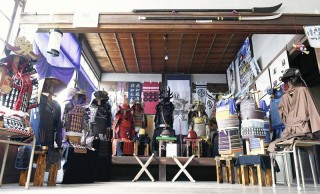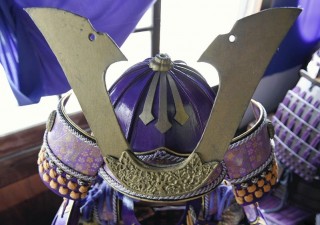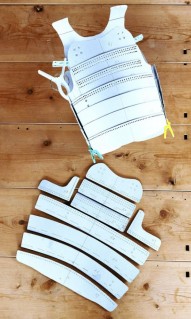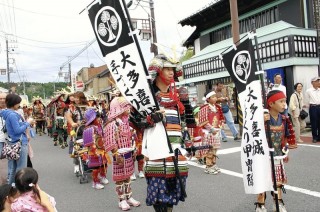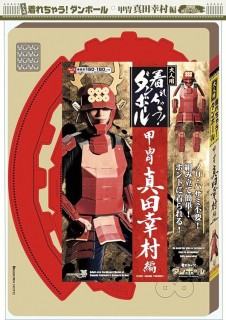Loading
Search
▼ Make And Wear Your Own Armor: Suit Up Like a Samurai With Some Everyday Materials (and a little patience)
- Category:Experience
Samurai warriors’ protective gear, called katchu in Japanese, is not only part of an old Japanese tradition but also the fruit of skilled craftsmanship. Katchu includes yoroi (body armor), kabuto (helmet) and other protective wear. It can be fun to view various katchu items on display at museums.
Life-size yoroi and kabuto can be made using cardboard and other materials that are easy to obtain. The finished works look very realistic if meticulously assembled. You can even make some armor to wear yourself if you want to feel the spirit of the samurai during the Sengoku warring states period from the late 15th century to the late 16th century.
Japanese armor is distinctive in appearance and detail. It originated in the Heian period (794 to the late 12th century), when the samurai class began to rise. Simple at first, it was gradually sculpted and other ornaments were added. During the Sengoku period, a new, advanced type of armor was designed, called tosei gusoku (modern armor). This was light, solid and easy to move in. Many suits of armor displayed in castles and museums today are this type.
Life-size yoroi and kabuto can be made using cardboard and other materials that are easy to obtain. The finished works look very realistic if meticulously assembled. You can even make some armor to wear yourself if you want to feel the spirit of the samurai during the Sengoku warring states period from the late 15th century to the late 16th century.
Japanese armor is distinctive in appearance and detail. It originated in the Heian period (794 to the late 12th century), when the samurai class began to rise. Simple at first, it was gradually sculpted and other ornaments were added. During the Sengoku period, a new, advanced type of armor was designed, called tosei gusoku (modern armor). This was light, solid and easy to move in. Many suits of armor displayed in castles and museums today are this type.
Authentic armor is made by specialized artisans using iron, gilt bronze, leather and other materials. Recently, some people have begun taking advantage of the popularity of armor to revitalize their hometowns.
Yoshinobu Kimizuka, 66, is one person doing just that in Otaki, Chiba Prefecture. The town was previously ruled by Honda Tadakatsu, a high-ranking retainer of Tokugawa Ieyasu, the founder of the Tokugawa shogunate.
Kimizuka operates Tezukuri Katchu Kobo Hakubido, a handmade armor studio, in the town.
Yoshinobu Kimizuka, 66, is one person doing just that in Otaki, Chiba Prefecture. The town was previously ruled by Honda Tadakatsu, a high-ranking retainer of Tokugawa Ieyasu, the founder of the Tokugawa shogunate.
Kimizuka operates Tezukuri Katchu Kobo Hakubido, a handmade armor studio, in the town.
“There were various types of katchu during the Sengoku period. It’s very interesting,” Kimizuka said. “If you carefully make your armor, you can give it a very real look.”
I learned from Kimizuka how to make a protective breastplate, called dou in Japanese. Before starting, you need materials including cardboard, thick paper and paint.
1. Trace patterns on cardboard and thick paper.
2. Cut out each part and stick them together using wood glue.
3. Attach wire for reinforcement to the back of each part with glue. Then paste thin, coarsely meshed cloth called kanreisha on it. Kanreisha is usually used on a plaster base.
4. Pierce holes in appropriate places as necessary.
5. Apply sealer, a liquid chemical to prime the bare plaster surface, and also a water-based paint. You should apply at least three layers of paint. This is necessary to make the surface as attractively glossy as leather, Kimizuka said.
6. Assemble these parts with special string, called odoshige, to finish. Odoshige is used to make genuine katchu. Use odoshige in various colors to make your work realistic.
To make a kabuto helmet, use a pattern in a similar fashion. Attach sponges to the interior to make it more comfortable to wear. The entire process takes many days, but according to Kimizuka, “the more time you spend, the more you will like your work.”
I learned from Kimizuka how to make a protective breastplate, called dou in Japanese. Before starting, you need materials including cardboard, thick paper and paint.
1. Trace patterns on cardboard and thick paper.
2. Cut out each part and stick them together using wood glue.
3. Attach wire for reinforcement to the back of each part with glue. Then paste thin, coarsely meshed cloth called kanreisha on it. Kanreisha is usually used on a plaster base.
4. Pierce holes in appropriate places as necessary.
5. Apply sealer, a liquid chemical to prime the bare plaster surface, and also a water-based paint. You should apply at least three layers of paint. This is necessary to make the surface as attractively glossy as leather, Kimizuka said.
6. Assemble these parts with special string, called odoshige, to finish. Odoshige is used to make genuine katchu. Use odoshige in various colors to make your work realistic.
To make a kabuto helmet, use a pattern in a similar fashion. Attach sponges to the interior to make it more comfortable to wear. The entire process takes many days, but according to Kimizuka, “the more time you spend, the more you will like your work.”
The finished items weigh about six to seven kilograms. If you draw your family crest on the breastplate or helmet, it can be a family treasure suitable for display in the tokonoma alcove in your drawing room.
Your armor can be maintained in good condition for a long time if you regularly clean it, such as by dusting its surface with a dry cloth.
Kimizuka’s studio usually does not accept orders for armor, but visitors are allowed to touch and try on displayed items.
Several handmade armor workshops are held from April to September every year in the town. Attendees in their own handmade armor can participate in a samurai parade during the annual Otaki Oshiro Matsuri festival in September.
Your armor can be maintained in good condition for a long time if you regularly clean it, such as by dusting its surface with a dry cloth.
Kimizuka’s studio usually does not accept orders for armor, but visitors are allowed to touch and try on displayed items.
Several handmade armor workshops are held from April to September every year in the town. Attendees in their own handmade armor can participate in a samurai parade during the annual Otaki Oshiro Matsuri festival in September.
A similar workshop is provided in places associated with military generals in the Sengoku period, such as Odawara, Kanagawa Prefecture, and Toyoake, Aichi Prefecture.
Inspired by media including NHK’s annual epic historical dramas, an increasing number of people of all ages are becoming interested in making armor by hand, Kimizuka said.
“You can learn about the Sengoku period by making armor and imagining the lives of past military generals,” Kimizuka said.
Kits available
Several handy kits for making cardboard armor are available to buy.
Kirechau! Danboru (Wearable cardboard armor) sold by Showa Note Co. includes perforated cardboard parts for easy assembly. It takes around 90 minutes to complete. There are designs representing Sanada Yukimura, Date Masamune and Maeda Toshiie. The three designs are available for children (¥2,480 and ¥2,980, plus tax), and two of them for adults (¥2,980 plus tax).
Inspired by media including NHK’s annual epic historical dramas, an increasing number of people of all ages are becoming interested in making armor by hand, Kimizuka said.
“You can learn about the Sengoku period by making armor and imagining the lives of past military generals,” Kimizuka said.
Kits available
Several handy kits for making cardboard armor are available to buy.
Kirechau! Danboru (Wearable cardboard armor) sold by Showa Note Co. includes perforated cardboard parts for easy assembly. It takes around 90 minutes to complete. There are designs representing Sanada Yukimura, Date Masamune and Maeda Toshiie. The three designs are available for children (¥2,480 and ¥2,980, plus tax), and two of them for adults (¥2,980 plus tax).
- October 24, 2016
- Comment (0)
- Trackback(0)


